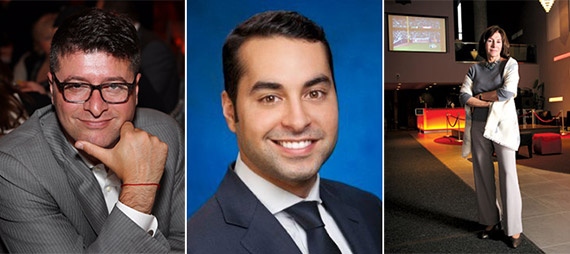Trending
Global gloom props up dollar …and NYC real estate
Global gloom props up dollar ...and NYC real estate

The strength of the greenback against other currencies is not weighing down foreign interest in New York real estate. Instead, international investors are even more likely to now view brick-and-mortar assets in the Big Apple as a protected place to store capital.
Last year, the U.S. dollar gained modestly on the Chinese yuan and the British pound and logged low double-digit increases against the euro and Japanese yen, making real estate here less affordable.
But foreign investment in New York City commercial real estate totaled $13.24 billion as of mid-December, up from $8.57 billion in 2013, according to Real Capital Analytics. And of course, record-breaking residential purchases by foreign buyers in the past year highlighted the desirability of New York homes for overseas investors too.
However, the dramatic slide of the Russian ruble in the waning days of 2014, along with desperate measures by the country’s government to halt it, may eventually reveal a tipping point when a currency’s decline is too much and could keep investors from buying real estate abroad.
“Economic turmoil causes people to lose money,” said Nancy Packes, owner of Nancy Packes Signature Marketing Services, a sales brokerage for new developments. She also noted, however, that many Russian investors would not keep all their liquid assets in their home currency. “So the question becomes, will the losses investors incur domestically severely impact their spending or investment pattern abroad?”
Safe haven
The strength of the dollar reflects a split in the world’s fortunes, with the steadily growing U.S. on one side and practically everyone else on the other. Stateside, the third-quarter gross domestic product growth was an impressive 5 percent, the fastest rate in a decade, up from the previous prediction of 3.9 percent.. The jobs picture here also remains positive, with employers adding 312,000 jobs in November, while average hourly earnings increased by the largest amount since June 2013.
“If the dollar is getting stronger, then that means the U.S. economy is getting stronger, making New York a better place to put money, given what’s going on in Europe,” said Jonathan Aghravi, senior director of Eastern Consolidated’s capital advisory division.
Woe is the World
Across the pond, Europe’s health looks uncertain. A private-sector survey of purchasing managers in the 18-nation currency bloc last month found that the Eurozone economy is still growing, although modestly. But the largest economies of the bloc showed troubling signs. German companies’ reported growth was the smallest since June 2013 and France logged the eighth straight month of declining activity.
Other areas of the globe look similarly risky. Japan’s economy shrank by 1.6 percent in the third quarter, prompting its central bank to ramp up stimulus and its prime minister to delay a planned increase in the country’s consumption tax. In China, manufacturing activity slowed in November, while inflation there hit a five-year low.
“We’re in a strong position compared with the rest of the world,” said Ed Mermelstein, a founding partner of real estate law firm Rheem Bell & Mermelstein, who has seen a recent uptick in investor interest in New York real estate from European and Asian individuals and institutional investors. “When the prices of commodities and currency are heading downward, holding real estate in the U.S. is better than holding the gold standard of yesteryear.”
Cheap by comparison
Another key attribute of U.S. real estate, both commercial and residential, is that it’s cheap, at least relatively speaking. And that makes it continually attractive to international investors. The United States was the top spot for foreign real estate investment in 2014 by a wide margin, outranking No. 2 Germany by 50 percentage points, according to the Association of Foreign Investors in Real Estate, an organization of real estate investment executives. New York City came in No. 2 in 2013 for foreign investment (after London). The new survey comes out this month.
“When we look at the Manhattan market, we look at it from a 10,000-foot view,” said Omer Ozden, executive director of acquisitions and finance for Xinyuan, which is developing The Oosten in Williamsburg, a condo building being built by and marketed heavily to Chinese investors. “Compared to Hong Kong, it’s an absolute bargain.”
For instance, a new Hong Kong luxury condo costs $5,300 per square foot, versus $2,400 per foot for the Manhattan equivalent, said Ozden. On the commercial side, cap rates for Manhattan properties are at 4.7 percent, versus 3.1 percent in Hong Kong, according to Real Capital Analytics.
“The bulk of the foreigners in the marketplace are looking at the value of the investment of real estate, especially trophy buildings,” said Melissa Cohn, president of GuardHill Financial, a New York-based mortgage company. “A 5-percent differential in the currency is not going to make or break them, in terms of making that investment in New York City.”
The Chinese, unruffled
Even as growth in their country slows from its previously unsustainable pace, Chinese investors haven’t been swayed from investing in New York, Ozden said. The country’s currency was relatively stable against the dollar over the last year, mostly because it’s not free-floating, but rather pegged to a basket of currencies with a very tight margin.
“It’s not going to fluctuate that much unless the government moves to depreciate or appreciate it,” said Ozden, who also pointed out that most Chinese investors’ money is already in U.S. dollars, so currency exchange rates are moot.
“Generally, it would have a neutral impact,” he said. “Or, for developers or long-term investors, if the dollar goes up, eventually they will sell in the dollar and will get the appreciation in the sales price.”
Russia: the cautionary tale?
The striking story of the ruble, though, may pose an example of when a currency’s plummet could stem NYC real estate investment. Oil-dependent Russia’s currency crashed last month, following a steady decline in oil prices.
“We don’t anticipate the ruble recovering,” Mermelstein said.
To try to halt the ruble’s slide, Russia’s central bank in mid-December hiked interest rates to 17 percent from 10.5 percent. The Russian Finance Ministry also pledged to sell $7 billion in foreign currency reserves to support the currency, which became free-floating in November. However, the economy minister promised Russia wouldn’t take draconian measures to keep money from flowing out of the country.
“Until last week, we had quite a bit of interest in planned developments going up in New York. Deals were moving forward. Investments were being made,” said Mermelstein in late December, regarding Russian investors. “We won’t know if there will be significant changes until after the 15th of January, when the holidays of Eastern Europe are over.”




